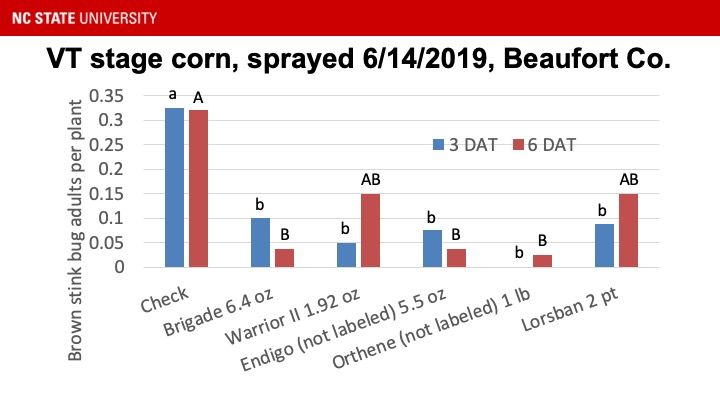Important Changes for Stink Bug Thresholds in Corn for 2020
go.ncsu.edu/readext?695203
en Español / em Português
El inglés es el idioma de control de esta página. En la medida en que haya algún conflicto entre la traducción al inglés y la traducción, el inglés prevalece.
Al hacer clic en el enlace de traducción se activa un servicio de traducción gratuito para convertir la página al español. Al igual que con cualquier traducción por Internet, la conversión no es sensible al contexto y puede que no traduzca el texto en su significado original. NC State Extension no garantiza la exactitud del texto traducido. Por favor, tenga en cuenta que algunas aplicaciones y/o servicios pueden no funcionar como se espera cuando se traducen.
Português
Inglês é o idioma de controle desta página. Na medida que haja algum conflito entre o texto original em Inglês e a tradução, o Inglês prevalece.
Ao clicar no link de tradução, um serviço gratuito de tradução será ativado para converter a página para o Português. Como em qualquer tradução pela internet, a conversão não é sensivel ao contexto e pode não ocorrer a tradução para o significado orginal. O serviço de Extensão da Carolina do Norte (NC State Extension) não garante a exatidão do texto traduzido. Por favor, observe que algumas funções ou serviços podem não funcionar como esperado após a tradução.
English
English is the controlling language of this page. To the extent there is any conflict between the English text and the translation, English controls.
Clicking on the translation link activates a free translation service to convert the page to Spanish. As with any Internet translation, the conversion is not context-sensitive and may not translate the text to its original meaning. NC State Extension does not guarantee the accuracy of the translated text. Please note that some applications and/or services may not function as expected when translated.
Collapse ▲The threshold for stink bugs in corn is changing based on recent research conducted in both North Carolina and Virginia. These studies indicated that, while seedling thresholds were effective, there was evidence that the pre-tasseling and early reproductive stages threshold should be lowered. We also shortened the period that stink bugs needed to be controlled from R4 to R2, since there is no evidence that brown stink bugs can cause economic yield loss (except, perhaps at very high levels) past R2. New thresholds are listed on our website.
A major concern in lowering these thresholds is that more unnecessary spraying will take place. Unfortunately, most stink bug sprays are made without proper scouting, often applied too late to reduce economic injury (typically tank mixed with a fungicide at tasseling), and without adequate coverage near the ear zone. These unneeded or poorly targeted sprays are wasted money to the grower and could create resistance issues in the future. Stink bugs tend to infest field edges, so it’s easy to get excited if scouting is done with a quick trip out of and back into the pickup cab. We still anticipate that, even with these threshold modifications, most corn fields will not exceed the economic threshold if they are properly scouted. Refer to the information on our website for our scouting recommendations. Bifenthrin is the most effective registered insecticide. Using off-label insecticides on corn is unneeded and illegal.


